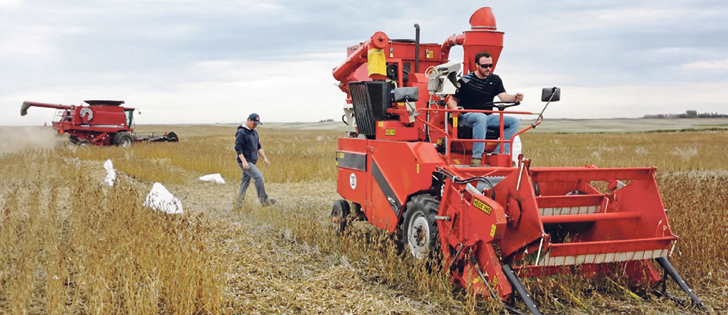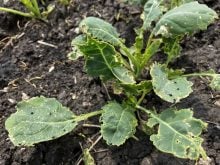When a seeding mistake occurs in a precise and repeatable manner, why not make the best of it and turn it into an experiment.
That’s more or less what happened to Scott Day last summer on his farm near Deloraine, Man.
Day was using his Seed Hawk on 10-inch spacings to seed soybean variety trials for the Minto Co-op. The field had grown peas, lentils and beans in the past but never soybeans.
In mid-May he direct seeded into heavy wheat stubble that had been cut low. The soybean trials were set up to accommodate a plot harvester.
Read Also

Growing garlic by the thousands in Manitoba
Grower holds a planting party day every fall as a crowd gathers to help put 28,000 plants, and sometimes more, into theground
The co-op had planned to compare six varieties but not inoculants. All the seed was supposed to have been treated with liquid inoculant before seeding.
However, before the drill took to the field, a manifold delivering granular inoculant to one quarter of the air seeder was accidentally shut off.
“Things were growing well, but after a few weeks that one plugged manifold became very noticeable,” Day said.
“You could see where the full inoculant treatment went on the soybeans. It looked great and the nodulation went right to the tips of the roots. With just the liquid seed treated inoculant, the only nodules were near the top of the taproot.”
Day said this occurred throughout his own field of BrettYoung Akras soybeans as well as in the trial plots where the seed was supposed to have been inoculated with liquid.
However, it appears that one of the competitor’s varieties was probably not treated with any inoculant in the trial plots. Photos show those roots are completely bare.
The strips where granular inoculant had not been applied was just a little wider than the plot combine, so Day asked the Westman Agricultural Diversification Organization crew to do a harvest trial on these strips.
They did four repetitions, but they weren’t randomized because the strips were in long straight lines the length of the field. The data in the accompanying chart makes it easy to spot the one variety that didn’t receive any inoculant.
The dramatic response to granular inoculant is also noticeable with all the varieties.
“Without granular inoculant, the yield average was 39.3 bushels, which for a novice soybean grower on their first field you would think it was pretty good, but add the granular stuff and it jumps almost 20 bu. to an average 57.3 bu. This is a part of the field where hog manure had been applied liberally years ago.”
The rest of the field was similar with the non-granular strips dropping 20 bu. Despite this, the Akras field averaged about 50 bu. across all acres, even with all the drown outs and some hail.
“Oh, what might have been if the inoculant had been applied to all acres,” said Day.
“But then again, we wouldn’t have had this neat little experiment.”


















